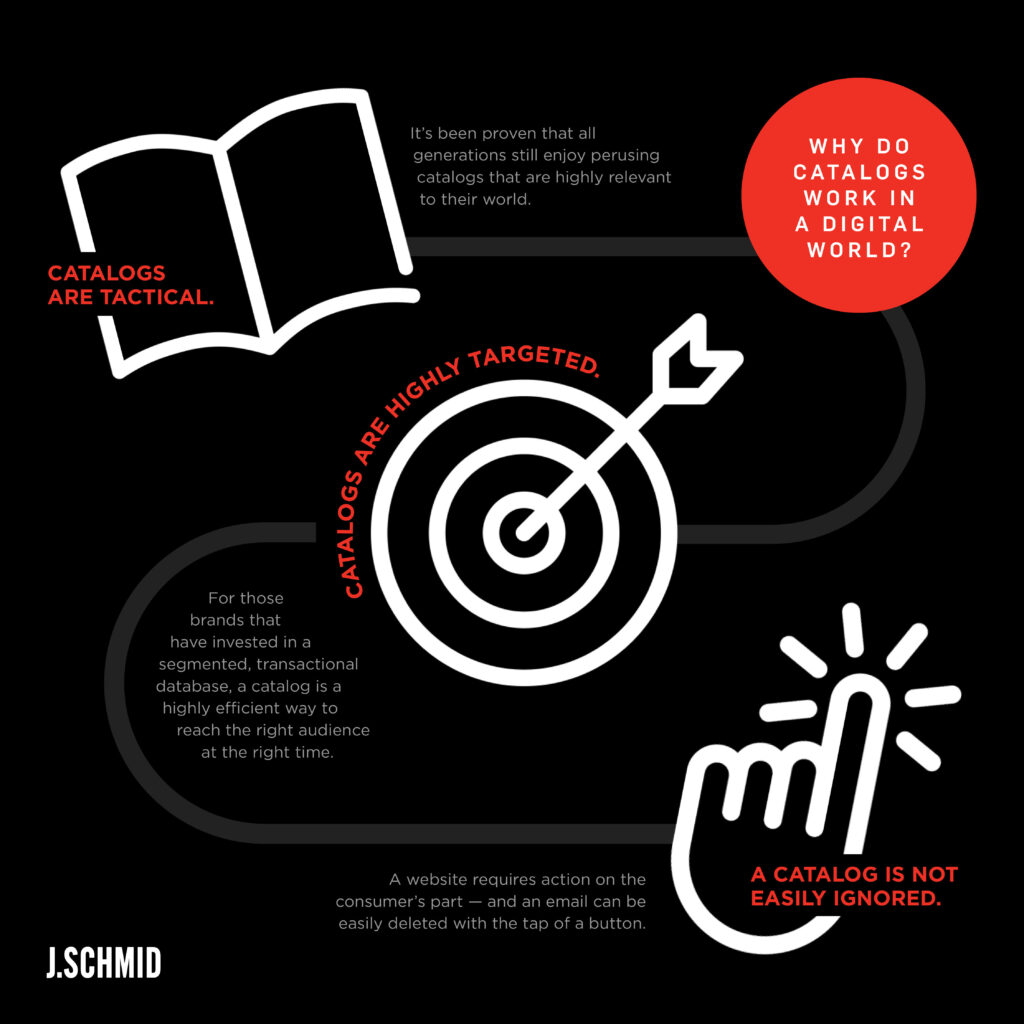
In a world in which digital marketing continues to grow, a new brand is still mailing a catalog for the first time every month. That’s not the strange part, however. What is strange is WHO is mailing these catalogs: e-commerce retailers. Amazon, Wayfair, One King’s Lane and Everlane are just a few examples of formerly online-only brands that took the leap into the catalog sphere. Ironically, one such catalog I received in the mail is called “OnlineShoes.com”! Furthermore, brands which have traditionally sold through brick-and-mortar stores are increasingly adding catalogs to drive traffic to both their website and stores.
The Power of Print
In many cases, these brands have discovered that by adding a catalog to the marketing mix, customer value increases fourfold! According to the Direct Marketing Association, close to 90 million Americans currently purchase from a catalog. Interestingly, nearly 60 percent of them are women. So why do catalogs still work in a digital world? Three reasons:

- It’s a proactive tap on the shoulder that one can’t easily ignore. A website is NOT proactive — it requires action on the consumer’s part (a visit to your site.) And potential shoppers can easily delete an email with the swipe of a finger.
- Catalogs are tactical, and research proves that all generations still enjoy perusing catalogs that are highly relevant to their world.
- Catalogs are highly targeted. When used with a segmented, transactional database, a catalog is a highly efficient way to reach the right audience at the right time.
How to Use It
How does one take advantage of this powerful tactic? The real takeaway is that you must fully understand the changing role of the catalog.
So what’s changed? Several emerging trends have created a tectonic shift in the role of the catalog. First, it’s no longer just a storefront. A catalog acts as an incredible advertising tactic driving customers to DO something — either to go online, go to a store or even engage on a social platform.
Once upon a time, it was imperative that a traditional cataloger presented their entire assortment or miss out on sales. This is no longer the case, with the online store’s ability to expand products and categories.
The Catalog Design
Finally, marketers continue to debate how a catalog should be designed. Should it follow the template of a traditional catalog? Should it be a collection of product stories with a heavy editorial footprint? Or maybe it should be more of a lookbook that intrigues the consumer into a branded experience? The truth is, I’ve seen all the above formats succeed at garnering exceptional response rates. It depends upon your brand, its merchandise concept, category differentiation and the alignment of your customers’ shopping needs.
Marketers also rush to jump into the “brand experience” camp. While brand engagement is critical, it’s important that brands continue to embrace the tried-and-true techniques that increase response and sales. Brands must be careful to not throw the baby (i.e., catalog best practices) out with the bathwater. A recent article in The New York Times scrutinized the resurgence of J.C. Penney’s catalog, noting how other brands have revamped their retail catalogs to create a more branded experience.
The Primary Goal
What hasn’t changed? Ultimately, just like any other advertising medium, the primary goal of a catalog is to increase sales. It is a powerful tactic designed to accomplish three things:
- DISRUPT consumers’ lives by grabbing attention with powerful design that’s highly relevant to your brand. This is especially critical on your covers, and opening and closing spreads — i.e., the most valuable real estate in a catalog.
- DELIGHT consumers with a landscape of imagery and copy meant to tell a brand and product story that’s relevant to their world. The more storytelling you present wrapped around a product category, the higher response you’ll see. And, most importantly, perceived uniqueness or exclusivity will delight more than anything else.
- DRIVE customers to DO something by creating engaging calls to action that deliver on a promise. This can include an invitation to more content, to a store for an event or even social engagement at the top of the sales funnel.
Yes, many more brands are realizing the power of catalogs and their importance to an omnichannel marketing mix. Ultimately, this incredible advertising tool must be strategically designed to sell and drive customer engagement which leads to a purchase. I truly believe the print catalog won’t be around forever. One of these days it will be replaced by a holographic and interactive experience. One can always dream!
Want find out if you’re ready to mail? Reach out for an assessment at info@jschmid.com!
Tags: Lois Brayfield, mailing a catalog, Strategy
